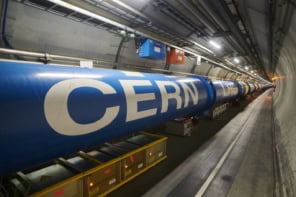
The European Physical Society (EPS) has defended its handling of its 2009 prize for high-energy and particle physics, despite complaints that the awarding committee has overlooked a vital scientific contribution to the prize-winning work. The biennial CHF5000 award, presented yesterday at a conference in Kraków, Poland, went to collaborators on the Gargamelle experiment at CERN for their 1973 discovery of the weak neutral current — one of the ways in which the weak nuclear force is mediated between fundamental particles. However, the award did not formally recognize the “leptonic” evidence for neutral currents, without which some particle physicists say the discovery could not have been made.
I am amazed and appalled that the leptonic neutral-current channel will not be recognized in the EPS prize Alan Michette, King’s College London
Several Gargamelle collaborators have contacted the EPS with their objections, with Alan Michette of King’s College London and Don Perkins of Oxford University requesting that their names be removed from the prize list. “I am amazed and appalled that the leptonic neutral-current channel will not be recognized in the EPS prize,” Michette told physicsworld.com. “In my opinion this is a historical and scientific error that is being committed in the face of all expert advice to the contrary.”
Smoking gun of unification
The discovery of weak neutral currents put the nascent standard model of particle physics — namely electroweak theory — on solid experimental ground. Until then, all known weak processes involved a rearrangement of electric charge (so called charged-current reactions) and historically could be described as taking place at a single point. But by the early 1970s a better theory of the weak force had emerged in which charged-current interactions are mediated by a charged particle called the W boson and a new interaction, mediated by a neutral particle called the Z boson, was predicted. The theory required that the Z particle would “mix” with the photon (the mediator of electromagnetism) such that the weak and electromagnetic forces were unified in a single theory.
The Gargamelle results allowed physicists to estimate the ratio of the masses of the W and Z particles, which were directly observed at CERN in the early 1980s and then studied in detail with the lab’s Large Electron Positron collider. That machine has since made way for the Large Hadron Collider, which should unearth the mechanism (widely expected to involve the Higgs boson) responsible for breaking the electroweak force into the two entities we perceive in the low-energy universe today.
Gargamelle, which was a bubble chamber that now stands outside on display near CERN’s main restaurant, recorded the first neutral-current event in December 1972. Filled with 12,000 litres of dense liquid in which charged particles leave trains of tiny bubbles, an electron (a type of particle called a lepton) appeared to have been kicked by an incoming neutrino, which leaves no bubble trace. Soon afterwards, the Gargamelle team had observed many more neutral-current events, this time when an incoming neutrino struck a proton (a type of particle called a hadron).
Vital confirmation
While there were many more “hadronic” events than there were “leptonic” ones, it was harder to pick them out from the bulk of background events that produced a similar signature, and it took a year for the Gargamelle results to be fully accepted. (In fact, an experiment at Fermilab in the US turned out to have already seen hadronic neutral-current events yet had put them down to neutrons). Since the electroweak theory made firmer predictions for the leptonic channel than it did the hadronic channel, largely because protons are not elementary particles, Gargamelle physicists say that the single-electron event was vital in confirming the neutral-current prediction.
Gerard ‘t Hooft of the University of Utrecht, who shared the 1999 Nobel physics prize for his theoretical work on electroweak interactions, says both the leptonic and hadronic contributions were important in the discovery of neutral currents, but that they were also rather different discoveries. “Now, of course, it’s obvious that there is a single weak interaction, but in those early days it was far from clear,” he said. “Having neutral currents among leptons doesn’t necessarily mean there are neutral currents among hadrons, and vice versa.”
Decision stands
The two Gargamelle results were published in September 1973: one paper reporting the leptonic event and the other the hadronic analysis. The controversy over this year’s EPS prize stems from the decision to award it only to authors of the hadronic paper, leaving four authors of the leptonic paper — Charles Baltay of Yale University, Michel Jaffre of IN2P3-CNRS in Orsay, Jacques Lemonne of Vrije Universiteit in Brussels and James Pinfold of the University of Alberta — out in the cold.
The leptonic channel was at least as important as the hadronic channel in confirming the discovery of neutral currents with Gargamelle James Pinfold, University of Alberta
“The leptonic channel was at least as important as the hadronic channel in confirming the discovery of neutral currents with Gargamelle,” says Pinfold, who wrote to the chair of the EPS High Energy and Particle Physics Division Board, Per Osland, on behalf of all four affected authors requesting that the board amend the prize accordingly. “My request was rebuffed,” he says.
In defence of its decision, the EPS cites the titles of the two neutral-current papers. “The Gargamelle collaboration did a variety of measurements and published many papers with a variety of authors,” Osland said. “The board decided to give the prize for the ‘observation of the weak neutral current interaction’, so it was then natural to point to the ‘Observation…’ paper, where observation was actually claimed, rather than the ‘Search for…’ paper, which presented the leptonic event but did not claim observation of the neutral current.” Osland added that the EPS can not remove names from the list of winners because that would amount to tampering with the list of authors of a paper published 36 years ago.
Michette, however, puts events down to bureaucratic intransigence. “The EPS decided to ignore the voices of a number of members of the Gargamelle Collaboration,” he said. “Simply put, the committee couldn’t admit that it had made a big mistake.”





